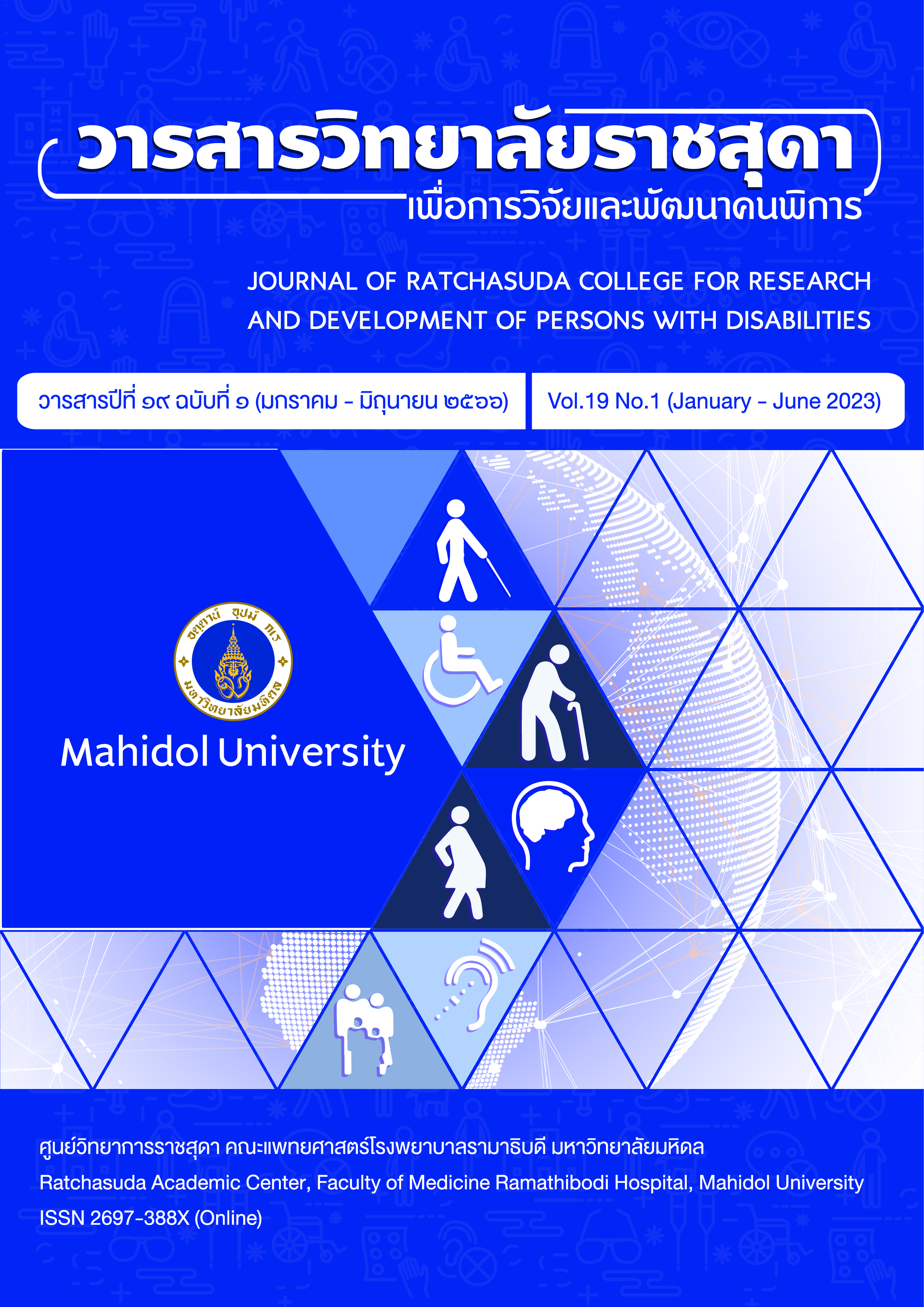การศึกษาผลการฟื้นฟูทักษะการฟัง ภาษา การพูด และปัจจัยที่เกี่ยวข้องในเด็กที่ผ่าตัดฝังประสาทหูเทียมใน 4 ภูมิภาค
คำสำคัญ:
ประสาทหูเทียม, การฟื้นฟูทักษะการฟัง, ภาษา การพูดบทคัดย่อ
งานวิจัยนี้มีวัตถุประสงค์ 1) เพื่อศึกษาผลของการฟื้นฟูทักษะการฟัง ภาษาและการพูดในเด็กที่ผ่าตัดฝังประสาทหูเทียม 2) เพื่อศึกษาปัจจัยที่มีผลต่อการฟื้นฟูทักษะทางภาษา การพูดและการฟัง 3) เพื่อหาค่าเฉลี่ยจำนวนครั้งอย่างน้อยในการฟื้นฟูที่เริ่มมีผลทำให้ความสามารถของเด็กเพิ่มขึ้น ทีมนักวิจัยร่วมกับโรงพยาบาลเครือข่าย 9 แห่ง ได้คัดกรองเด็กที่ผ่านเกณฑ์ผ่าตัดฝังประสาทหูเทียมและฟื้นฟูสมรรถภาพ 13 ราย ที่มีอายุระหว่าง 1-4 ปี เด็กได้รับการผ่าตัดแล้วฟื้นฟูทักษะการฟัง ภาษาและการพูด สัปดาห์ละ 1 ครั้ง ครั้งละ 30-60 นาที ต่อเนื่อง 2 ปี มีการวัดผลลัพธ์โดยประเมินด้านภาษาและการพูดทั้งหมด 6 ครั้ง ได้แก่ ประเมินก่อนผ่าตัด 1 ครั้ง และประเมินหลังผ่าตัด 5 ครั้ง ในช่วงระยะ 1, 3, 6, 12, 24 เดือนหลังการฝึกครั้งแรก โดยใช้แบบประเมิน Check Lists คำศัพท์ 100 คำแรกของเด็ก, Ling’s Six Sound Test, CAP Scales, และ Articulation Test โดยใช้สถิติเชิงพรรณนา สถิติ One Way Repeated Measure ANOVA และ Multiple Regression ผลการศึกษาพบว่า คะแนนเฉลี่ยรวมจากการประเมิน 3 ด้าน ได้แก่ ด้านการฟัง ด้านภาษา และความชัดเจนของเสียงพูด ของกลุ่มตัวอย่างที่ผ่าตัดฝังประสาทหูเทียมและวัดผลในช่วงอายุ 1, 3, 6, 12 และ 24 เดือน หลังผ่าตัด มีผลคะแนนเท่ากับ 17.9±11.6, 27.7±13.4, 37.2±14.2, 55.3±26.7 และ 109.3±82.7 ตามลำดับ ซึ่งทุกช่วงมีค่าคะแนนมากกว่าคะแนนเฉลี่ยในช่วงก่อนการผ่าตัดซึ่งได้คะแนน 6.3±9.0 อย่างมีนัยสำคัญทางสถิติ (p<0.05) ตัวแปรที่มีผลมากที่สุด คือ อายุ โดยอายุของกลุ่มตัวอย่างที่เพิ่มขึ้น 1 ปีหลังจากได้รับการฝึก คะแนนเฉลี่ยจะมีค่าเพิ่มขึ้น 19.0 คะแนน และต้องใช้เวลาฟื้นฟูอย่างน้อย 4 ครั้ง ภายใน 1 เดือนจึงจะทำให้ความสามารถของเด็กเพิ่มขึ้น สรุปได้ว่า รูปแบบกระบวนการคัดกรอง ผ่าตัด และฟื้นฟูเด็กที่ผ่าตัดฝังประสาทหูเทียมที่ใช้ในการดำเนินการวิจัยครั้งนี้ สามารถใช้เป็นต้นแบบสำหรับการคัดกรอง ผ่าตัด และฟื้นฟูสมรรถภาพด้านการฟัง ภาษาและการพูดในเด็กที่มีความบกพร่องทางการได้ยิน เนื่องจากมีกระบวนการที่ครอบคลุมครบถ้วน และได้ตระหนักถึงปัจจัยที่มีผลต่อการฟื้นฟู ทำให้เห็นว่ากลุ่มตัวอย่างทุกรายมีศักยภาพที่ดีขึ้น รวมถึงเป็นรูปแบบที่ทำให้เกิดการทำงานแบบบูรณาการร่วมกันของแพทย์ พยาบาล และนักวิชาชีพที่เกี่ยวข้อง เช่น นักเวชศาสตร์การสื่อความหมาย โดยเฉพาะผู้ปกครองที่เป็นกำลังสำคัญในการดูแลเด็กอย่างต่อเนื่องต่อไป
Downloads
References
American Speech-Language Hearing Association. (2011). Aural/Audiologic Habilitation for Children. Retrieved from https://www.asha.org/uploadedFiles/AIS-Aural-Audiologic-Habilitation-Children.pdf.
Aussie Deaf Kids. (2015). Enhancing communication with hearing impaired children and wearers of hearing aids. Retrieved from https://www.aussiedeafkids.org.au/enhancing-communication-with-hearing-impaired-children-and-wearers-of-hearing-aids.html.
Bradham, T. S., & Houston, K. T. (2015). Assessing listening and spoken language in children with hearing loss. San Diego: Plural Publishing.
Butterfield, S. A. (1991). Influenceofage, sex,hearing lossand balanceon development of running by deaf children. Retrieved from https://www.ncbi.nlm. nih.gov/ pubmed/1766796.
Butterfield, S. A. & Erising, W. F. (1986). Influenceofage, sex, etiology,and hearing losson balance performance by deaf children. Retrieved from https://www.researchgate.net/publication/19659196_Influence_of_age_sex_etiology_and_hearing_loss_on_balance_performance_by_deaf_children.
Cole, E. B., & Flexer, C. (2011). Children with hearing loss developing listening and talking. San Diego: Plural Publishing.
Cooper, H. (1991). Cochlear implants: a practical guide. London: Whurr Publishers.
Dardarananda, R., Akamanon, C., & Decongkit, S. (1986). Speech disorders. Bangkok: Ruengaew Publishing.
Dickson, N. C. (2013). Track a listening child. Retrieved from https://www.com/0f576aaf-45ce-4256-9b3b 72663bf661/general _ rehabilitationresources _ earlyintervention _ trackalisteningchild%28tlc%29_en_3.31mb.pdf? MOD=AJPERES&CONVERT_TO=url&CACHEID=ROOTWORKSPACE-0f576aaf-45ce-4256-9b3b-e772663bf661-l5rD6NH.
Erber, N. P. (1982). Auditory, visual, and auditory-visual perception of vowels by hearing-impaired children. Journal of Speech, Language, and Hearing Research, 25(1), 100-107.
Estabrooks, W. (2006). Auditory-verbal therapy and practice. Washington DC: Alex Graham Bell Assn for Deaf.
Jerry, L. (1991). Northern: hearing in children. 4th edition. Baltimore: William & Wilkins.
Katz, J. (1994). Handbook of clinical audiology. 4th edition. Maryland: William & Wilkins.
Komin, K. (2008). know the device 'Cochlear implants', the gateway to a sound life Retrieved from http://www.hopetohear.net/special_story1_ci_doctor.html.
Kretschmer, R. R., Kretschmer, L. & W. (1978). Language development and intervention with the hearing impaired. Baltimore: University Park Press.
Lertsukprasert, K. (2007). Congenital hearing loss: Diagnosis & rehabilitation. Bangkok: Kochakorn Publishing.
Lim, S. Y. C., & Simser, J. (2005). Auditory-verbal therapy for children with hearing impairment. Ann Acad Med Singapore, 34(4), 307-312.
Ling, D. (1989). Foundations of spoken language for hearing-impaired children. Washington DC: Alexander Graham Bell Association for the Deaf.
Ling, D. (1976). Speech and the hearing-impaired child: Theory and practice. Washington DC: Alexander Graham Bell Association for the Deaf.
Luangpitakchumpon, P. (2010). Assessing the listening and speaking abilities of deaf children using cochlear implants aged 1 – 5 years. Bangkok: Aekkarnpim Publishing.
Luterman, D., & Kurtzer-White, E. (1999). Identifying hearing loss: Parents' needs. American Journal of Audiology, 8(1) 13-18.
Manochiopinig, S., Pracharitpukdee, N., & Lertsarunyapong, S. (1998). The Articulation Characteristics of Normal Thai Children aged 3 - 10 years Assessing by Using the Thai Articulation Test (TAT). Siriraj Medical Journal, 8(50), 763-769.
Patarapak, S. (2014). Oto-Neurotology. Bangkok: V.Print Publishing
Prathanee, B. (1995). Speech and language disorders. Khonkaen: The handout of Department of Otolaryngology Khonkaen University.
Roland, P. S., Meyerhoff, W. L., & Marple, B. F. (Eds.). (1997). Hearing loss. New York: New York Thieme Medical Publishing.
Saksiriphol, D. (2019). Hearing and speech development in children with hearing impairment. Retrieved from http://rise.swu.ac.th/Portals/184/documents/articles/Developing_ Listening_ and_Spoken_Language_Skills-03.pdf.
Sirindhorn National Medical Rehabilitation Institute. (2020). Manual guidline for operationing screening and auditory verbal language rehabilitation in the child with cochlear implant. Bangkok: Aroon Publishing.
Thammasaeng, M. & Saksiriphol, D. (2007). Using listening to treatment speech problem. Encylopedia of education, 23(40), 40-48.
Thawin, C., Kanchanalarp, C., Lertsukprasert, K., Cheewaruangroj, W., Khantapasuantara, K. & Ruencharoen. S. (2006). Auditory Performance of Cochlear Implant Children Aged 2-5 Years. Retrieved from http://www.ncbi.nlm.nih.gov/pubmed/17205875.
The Royal college of Otolaryngologists Head and Neck Surgeons of Thailand. (2012). The guideline for cochlear implant surgery in Thailand. Bangkok: Chulalongkorn University Printing House.
Tyler, R. S. (1993). Cochlear implants audiological foundations. San Diego: Singular Publishing.
Downloads
เผยแพร่แล้ว
How to Cite
ฉบับ
บท
License
Copyright (c) 2023 ศูนย์วิทยาการราชสุดา คณะแพทยศาสตร์โรงพยาบาลรามาธิบดี มหาวิทยาลัยมหิดลบทความที่ได้รับการตีพิมพ์เป็นลิขสิทธิ์ของวารสารสถาบันราชสุดาเพื่อการวิจัยและพัฒนาคนพิการ





